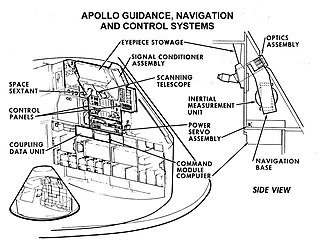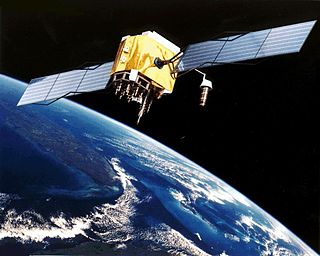Technologies
Multiple technologies exist to determine the position and orientation of an object or person in a room, building or in the world.
Acoustic positioning
| | This section is empty. You can help by adding to it. (April 2022) |
Time of flight
Time of flight systems determine the distance by measuring the time of propagation of pulsed signals between a transmitter and receiver. When distances of at least three locations are known, a fourth position can be determined using trilateration. Global Positioning System is an example.
Optical trackers, such as laser ranging trackers suffer from line of sight problems and their performance is adversely affected by ambient light and infrared radiation. On the other hand, they do not suffer from distortion effects in the presence of metals and can have high update rates because of the speed of light. [7]
Ultrasonic trackers have a more limited range because of the loss of energy with the distance traveled. Also they are sensitive to ultrasonic ambient noise and have a low update rate. But the main advantage is that they do not need line of sight.
Systems using radio waves such as the Global navigation satellite system do not suffer ambient light, but still need line of sight.
Spatial scan
A spatial scan system uses (optical) beacons and sensors. Two categories can be distinguished:
- Inside out systems where the beacon is placed at a fixed position in the environment and the sensor is on the object [8]
- Outside in systems where the beacons are on the target and the sensors are at a fixed position in the environment
By aiming the sensor at the beacon the angle between them can be measured. With triangulation the position of the object can be determined.
Inertial sensing
The main advantage of an inertial sensing is that it does not require an external reference. Instead it measures rotation with a gyroscope or position with an accelerometer with respect to a known starting position and orientation. Because these systems measure relative positions instead of absolute positions they can suffer from accumulated errors and therefore are subject to drift. A periodic re-calibration of the system will provide more accuracy.
Mechanical linkage
This type of tracking system uses mechanical linkages between the reference and the target. Two types of linkages have been used. One is an assembly of mechanical parts that can each rotate, providing the user with multiple rotation capabilities. The orientation of the linkages is computed from the various linkage angles measured with incremental encoders or potentiometers. Other types of mechanical linkages are wires that are rolled in coils. A spring system ensures that the wires are tensed in order to measure the distance accurately. The degrees of freedom sensed by mechanical linkage trackers are dependent upon the constitution of the tracker's mechanical structure. While six degrees of freedom are most often provided, typically only a limited range of motions is possible because of the kinematics of the joints and the length of each link. Also, the weight and the deformation of the structure increase with the distance of the target from the reference and impose a limit on the working volume. [8]
Phase difference
Phase difference systems measure the shift in phase of an incoming signal from an emitter on a moving target compared to the phase of an incoming signal from a reference emitter. With this the relative motion of the emitter with respect to the receiver can be calculated.
Like inertial sensing systems, phase-difference systems can suffer from accumulated errors and therefore are subject to drift, but because the phase can be measured continuously they are able to generate high data rates. Omega (navigation system) is an example.
Direct field sensing
Direct field sensing systems use a known field to derive orientation or position: A simple compass uses the Earth's magnetic field to know its orientation in two directions. [8] An inclinometer uses the earth gravitational field to know its orientation in the remaining third direction. The field used for positioning does not need to originate from nature, however. A system of three electromagnets placed perpendicular to each other can define a spatial reference. On the receiver, three sensors measure the components of the field's flux received as a consequence of magnetic coupling. Based on these measures, the system determines the position and orientation of the receiver with respect to the emitters' reference.
Optical systems
Optical positioning systems are based on optics components, such as in total stations. [9]
Magnetic positioning
Magnetic positioning is an IPS (Indoor positioning system) solution that takes advantage of the magnetic field anomalies typical of indoor settings by using them as distinctive place recognition signatures. The first citation of positioning based on magnetic anomaly can be traced back to military applications in 1970. [10] The use of magnetic field anomalies for indoor positioning was instead first claimed in papers related to robotics in the early 2000. [11] [12]
Most recent applications can employ magnetic sensor data from a smartphone used to wirelessly locate objects or people inside a building. [13]
There is currently no de facto standard for IPS, however magnetic positioning appears to be the most complete and cost effective[ citation needed ]. It offers accuracy without any hardware requirements and a relatively low total cost of ownership[ citation needed ]. According to Opus Research magnetic positioning will emerge as a “foundational” indoor location technology. [14]Hybrid systems
Because every technology has its pros and cons, most systems use more than one technology. A system based on relative position changes like the inertial system needs periodic calibration against a system with absolute position measurement. Systems combining two or more technologies are called hybrid positioning systems. [15]
Hybrid positioning systems are systems for finding the location of a mobile device using several different positioning technologies. Usually GPS (Global Positioning System) is one major component of such systems, combined with cell tower signals, wireless internet signals, Bluetooth sensors, IP addresses and network environment data. [16]
These systems are specifically designed to overcome the limitations of GPS, which is very exact in open areas, but works poorly indoors or between tall buildings (the urban canyon effect). By comparison, cell tower signals are not hindered by buildings or bad weather, but usually provide less precise positioning. Wi-Fi positioning systems may give very exact positioning, in urban areas with high Wi-Fi density - and depend on a comprehensive database of Wi-Fi access points.
Hybrid positioning systems are increasingly being explored for certain civilian and commercial location-based services and location-based media, which need to work well in urban areas in order to be commercially and practically viable.
Early works in this area include the Place Lab project, which started in 2003 and went inactive in 2006. Later methods let smartphones combine the accuracy of GPS with the low power consumption of cell-ID transition point finding. [17] In 2022, the satellite-free positioning system SuperGPS with higher-resolution than GPS using existing telecommunications networks was demonstrated. [18] [19]














